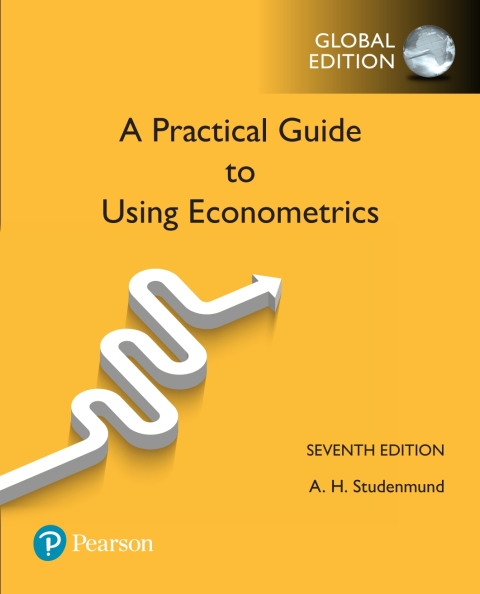Description
Efnisyfirlit
- Title Page
- Copyright Page
- The Pearson Series in Economics
- Contents
- Preface
- Chapter 1: An Overview of Regression Analysis
- 1.1. What Is Econometrics?
- 1.2. What Is Regression Analysis?
- 1.3. The Estimated Regression Equation
- 1.4. A Simple Example of Regression Analysis
- 1.5. Using Regression Analysis to Explain Housing Prices
- 1.6. Summary and Exercises
- 1.7. Appendix: Using Stata
- Chapter 2: Ordinary Least Squares
- 2.1. Estimating Single-Independent-Variable Models with OLS
- 2.2. Estimating Multivariate Regression Models with OLS
- 2.3. Evaluating the Quality of a Regression Equation
- 2.4. Describing the Overall Fit of the Estimated Model
- 2.5. An Example of the Misuse of R 2
- 2.6. Summary and Exercises
- 2.7. Appendix: Econometric Lab #1
- Chapter 3: Learning to Use Regression Analysis
- 3.1. Steps in Applied Regression Analysis
- 3.2. Using Regression Analysis to Pick Restaurant Locations
- 3.3. Dummy Variables
- 3.4. Summary and Exercises
- 3.5. Appendix: Econometric Lab #2
- Chapter 4: The Classical Model
- 4.1. The Classical Assumptions
- 4.2. The Sampling Distribution of
- 4.3. The Gauss–Markov Theorem and the Properties of OLS Estimators
- 4.4. Standard Econometric Notation
- 4.5. Summary and Exercises
- Chapter 5: Hypothesis Testing and Statistical Inference
- 5.1. What Is Hypothesis Testing?
- 5.2. The t-Test
- 5.3. Examples of t-Tests
- 5.4. Limitations of the t-Test
- 5.5. Confidence Intervals
- 5.6. The F-Test
- 5.7. Summary and Exercises
- 5.8. Appendix: Econometric Lab #3
- Chapter 6: Specification: Choosing the Independent Variables
- 6.1. Omitted Variables
- 6.2. Irrelevant Variables
- 6.3. An Illustration of the Misuse of Specification Criteria
- 6.4. Specification Searches
- 6.5. An Example of Choosing Independent Variables
- 6.6. Summary and Exercises
- 6.7. Appendix: Additional Specification Criteria
- Chapter 7: Specification: Choosing a Functional Form
- 7.1. The Use and Interpretation of the Constant Term
- 7.2. Alternative Functional Forms
- 7.3. Lagged Independent Variables
- 7.4. Slope Dummy Variables
- 7.5. Problems with Incorrect Functional Forms
- 7.6. Summary and Exercises
- 7.7. Appendix: Econometric Lab #4
- Chapter 8: Multicollinearity
- 8.1. Perfect versus Imperfect Multicollinearity
- 8.2. The Consequences of Multicollinearity
- 8.3. The Detection of Multicollinearity
- 8.4. Remedies for Multicollinearity
- 8.5. An Example of Why Multicollinearity Often Is Best Left Unadjusted
- 8.6. Summary and Exercises
- 8.7. Appendix: The SAT Interactive Regression Learning Exercise
- Chapter 9: Serial Correlation
- 9.1. Time Series
- 9.2. Pure versus Impure Serial Correlation
- 9.3. The Consequences of Serial Correlation
- 9.4. The Detection of Serial Correlation
- 9.5. Remedies for Serial Correlation
- 9.6. Summary and Exercises
- 9.7. Appendix: Econometric Lab #5
- Chapter 10: Heteroskedasticity
- 10.1. Pure versus Impure Heteroskedasticity
- 10.2. The Consequences of Heteroskedasticity
- 10.3. Testing for Heteroskedasticity
- 10.4. Remedies for Heteroskedasticity
- 10.5. A More Complete Example
- 10.6. Summary and Exercises
- 10.7. Appendix: Econometric Lab #6
- Chapter 11: Running Your Own Regression Project
- 11.1. Choosing Your Topic
- 11.2. Collecting Your Data
- 11.3. Advanced Data Sources
- 11.4. Practical Advice for Your Project
- 11.5. Writing Your Research Report
- 11.6. A Regression User’s Checklist and Guide
- 11.7. Summary
- 11.8. Appendix: The Housing Price Interactive Exercise
- Chapter 12: Time-Series Models
- 12.1. Distributed Lag Models
- 12.2. Dynamic Models
- 12.3. Serial Correlation and Dynamic Models
- 12.4. Granger Causality
- 12.5. Spurious Correlation and Nonstationarity
- 12.6. Summary and Exercises
- Chapter 13: Dummy Dependent Variable Techniques
- 13.1. The Linear Probability Model
- 13.2. The Binomial Logit Model
- 13.3. Other Dummy Dependent Variable Techniques
- 13.4. Summary and Exercises
- Chapter 14: Simultaneous Equations
- 14.1. Structural and Reduced-Form Equations
- 14.2. The Bias of Ordinary Least Squares
- 14.3. Two-Stage Least Squares (2SLS)
- 14.4. The Identification Problem
- 14.5. Summary and Exercises
- 14.6. Appendix: Errors in the Variables
- Chapter 15: Forecasting
- 15.1. What Is Forecasting?
- 15.2. More Complex Forecasting Problems
- 15.3. ARIMA Models
- 15.4. Summary and Exercises
- Chapter 16: Experimental and Panel Data
- 16.1. Experimental Methods in Economics
- 16.2. Panel Data
- 16.3. Fixed versus Random Effects
- 16.4. Summary and Exercises
- Appendix A: Answers
- Appendix B: Statistical Tables
- Index
- Back Cover






Reviews
There are no reviews yet.